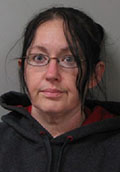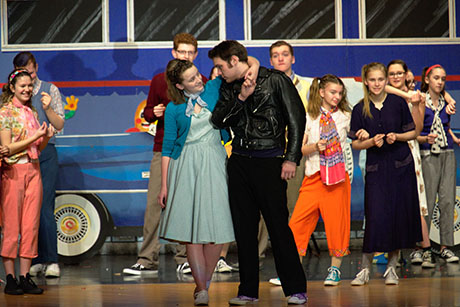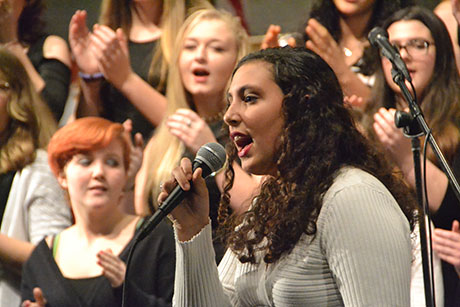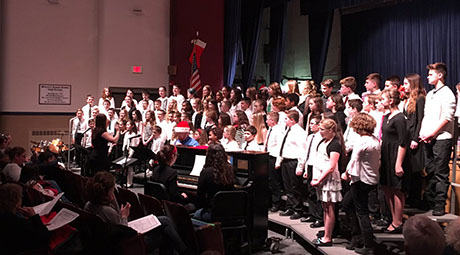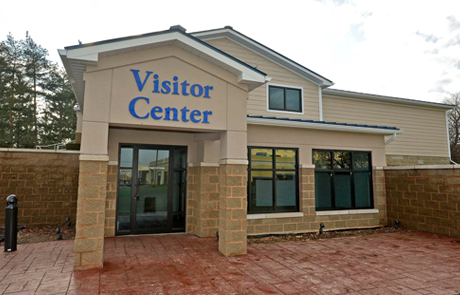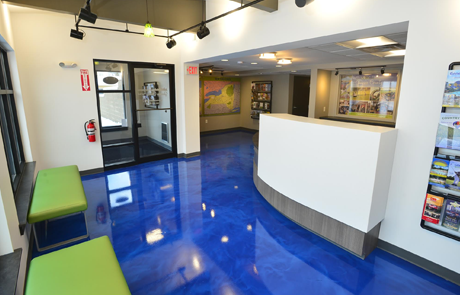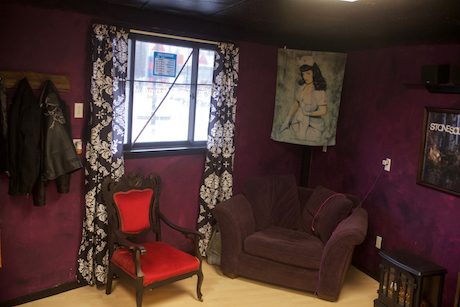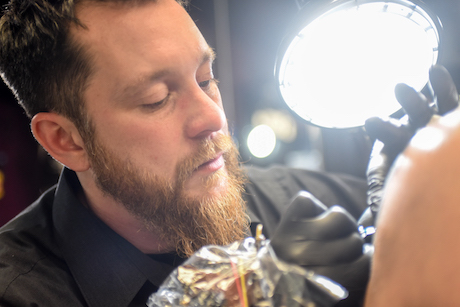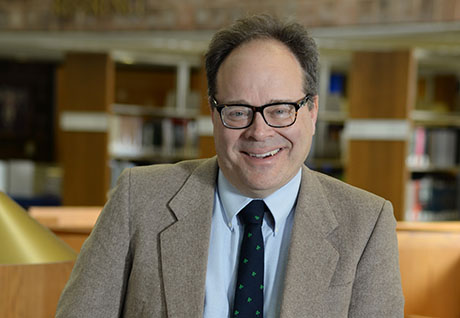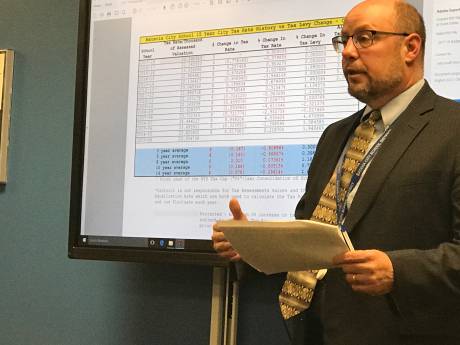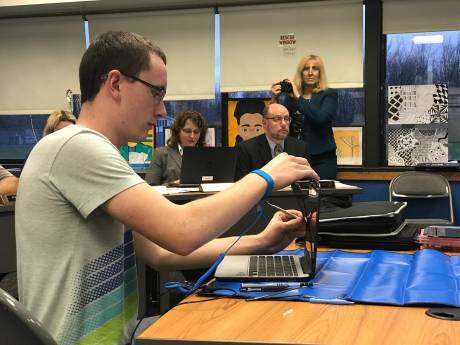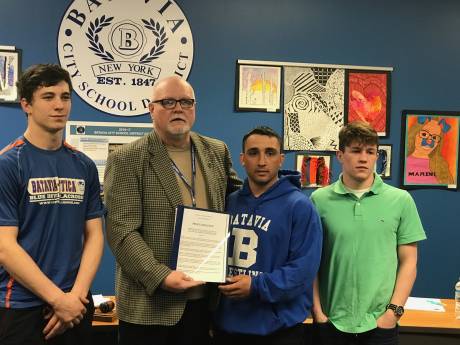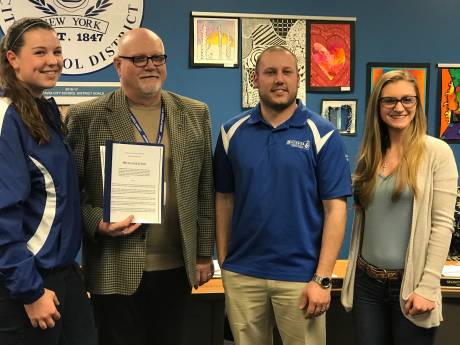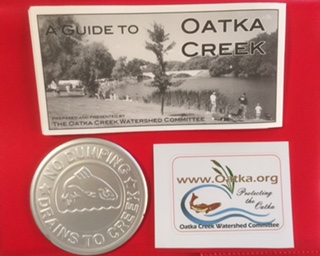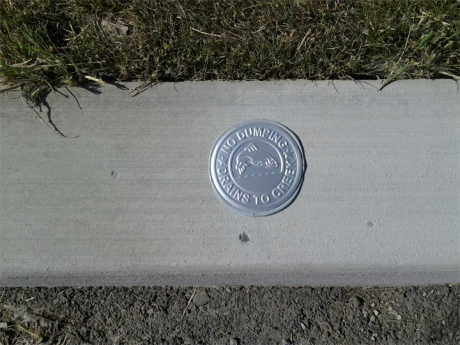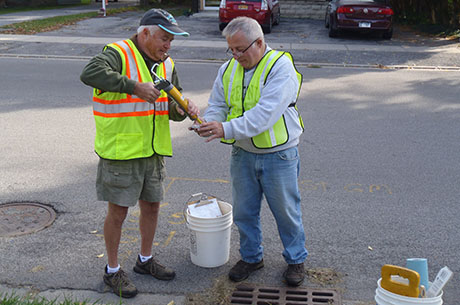Like most emerging artists, when Andy Carter was first learning his craft, he experimented with materials he had available to him at the time – crayons, markers, paint, a pen, a Walkman, and a toothbrush. All the tools necessary for an artist?
But Carter doesn’t just put ink to paper or canvas, well, he does use a “canvas,” just of a different nature – skin. The Pike resident is the owner and tattoo artist of Revelation Ink. The new tattoo shop, located at 10594 Main St. (Route 98), Alexander, is the goal he has been working toward for more than 20 years.
Although Carter had been drawing since he was 7 years old, when he was around 15 or 16, a “buddy” of his “got out of jail” and showed him how to make a tattoo gun. And being the creative sort, he made one out of a Walkman motor, a pen, a toothbrush, and sewing needles.
“I just started tattooing my friends with this thing. Some of them still have the tats and refuse to get them covered up – though I have covered-up some of them. Back then you had to order this stuff (tattooing equipment) but I didn’t know where to get it and I didn’t have the money. So, I did what I always do, figured out how to make one.”
It would be called a “rotary machine,” and he would wrap string around the needle to hold the ink for the tattoo that way.
“I can’t even believe I did it. I did some pretty good ones for not knowing anything about it. Now I have professional equipment and am much better at it.
“When I was in first grade, my mom’s friends babysat me and I would draw on their kids' arms with markers or Sharpies or whatever I could get my hands on. I just thought it was cool. I never thought about tattooing. One day my buddy’s dad came home and asked if I had ever thought about tattooing. I didn’t even know what it was. He brought me a tattoo (magazine) or Easy Rider magazine, I can’t remember what it was, but it had tattoos in it and I thought it was the coolest.”
When he was in school, he “loved evil things,” like “bones and skulls and blood.” He said he teachers would ask “Why do you draw stuff like that? Why not draw a pretty flower or something?” But, he didn’t want to draw flowers, until he met his high school Art teacher, Parry Ryan.
“She’s still the Art teacher there, at the Attica school, she would take my pictures and look at them and be like ‘Andy, that’s a beautiful skull, you should add a few more and put some more blood in there.’ She was just awesome. She didn’t judge you. She was just a great person.
“A few years ago, a friend of mine’s daughter texted me a picture she got from Art class, she took a picture…Miss Ryan still has my artwork up and she puts it on an easel when she is doing certain projects. That’s pretty cool, since the work was done 20 years ago. That’s pretty cool knowing that not everyone is judgmental about your artwork.”
When he was a child, his mom would buy him coloring books. He would spend hours coloring the pictures and tracing them out.
“We didn’t have video games then, well…we had Atari, but who wanted to play Atari? That’s the only thing I had was my art. That was the only thing I was interested in.”
While tattoo artists consider the skin their “canvas,” Carter says the biggest difference is “You hurt people this way.” Getting a tattoo is not a painless process.
“It’s really no different for me, there are just different techniques that you have to use. It’s just like any other artwork when you go from watercolors, to acrylics, to oils, to colored pencils – to skin – it’s all different art. Tattoo ink is more like a water-based ink and it’s FDA approved, because it has to be sterile.”
While Carter had the desire to take the plunge and become his own business owner, he “had to wait” until his wife got out of college.
“I wanted to do something that I truly wanted to do and my wife has been incredibly supportive of me. She just wants me to be happy. I paint still and still draw, but I can make more money this way. You can’t make money as an artist unless you’re dead or have the right connections. Out here…I don’t have the right connections living out here, so tattooing is the only way that I can actually make a living doing my art.”
So he just decided to be an artist.
While he says the jump was “scary” – going from a solid career to an uncertain one – the excitement of not really knowing what the next day will bring keeps the “creativity fresh.”
“I was put on this earth to make art and that’s what I’m going to do. I just wanted to be…I’ve always loved painting and drawing and once I discovered tattooing, I wanted to do that, too. I’ve been a woodworker for most of my life – the last 12 years. Now…I come here and hang out and draw on people all day. And I talk to people, that’s what I’m good at…talking.”
While Carter likes the process of coming up with a design, he does need to actually talk to a person about their ideas for him to come up with something unique. Chuckling, he had said it was “kinda hard” to draw something when he just gets a text with a picture that adds “I want this, but can you make it a little different?"
“I need a bit more than that. When someone comes into the shop with an idea…they give me a bit of background on the idea and why and I can take that and work up something that is meaningful to them. They give me ideas of what they like and such…it’s a fun process. It can be frustrating at times – getting it right – but when they walk out of here happy…I’m happy.”
His new venture allows him to meet a lot of different types of people and, depending on the tattoo, he can spend anywhere from a few minutes to several hours with one client.
“I can spend five hours with one person, so I get to know the people and hear their stories and the things they have gone through or are going through. I get to meet some really awesome people and hear some really awesome stories.”
One customer had wanted a tattoo with butterflies and skulls, but the skulls she wanted “hidden” because she works at the school and didn’t want to “scare” anyone. And as an added challenge, it was a cover up.
“Skulls are my specialty, but now that I’m 40 I really started getting into flowers and calligraphy and letters. I just love it. Flowers are awesome to do because they are so colorful, I hated them as a kid but now I like them.”
Although Carter views the skin as his canvas, the color of the “canvas” does make a difference with respect to the brightness of a color.
“Pasty white people are the best to tattoo because the colors just show up more vibrant.”
Then he began to tic off a multitude of other differences.
“Women have the best skin to tattoo because their skin is soft and the needle can penetrate the skin more easily. Men are tougher to tattoo because their skin is a bit rougher, but you can tell a difference in tattooing someone who does manual labor or works in an office. The darker you are…you’re not going to get the reds and yellows and whites in your skin, because it’s not really going to show up. So I’d generally use black.”
He also warns that just as tanned skin fades when it is exposed to less sunshine, a tattoo will fade if exposed to too much.
“Every time you are in the sun and don’t use something to protect your skin…it will fade over time. But, you also have to take care of them even for years after to maintain the color and quality of the tattoo.”
Additionally, because some colors, like yellows and whites, fade quicker than others, Carter tends to only use those colors for shading. Not only can he tell how colors will look on different skin tones, he can also tell how a session will go by looking at a person's skin.
“Different parts of the body are more sensitive, like the ribs or elbows. I’ve had grown men in the fetal position getting their ribs done. Another guy fell asleep because it didn’t even hurt him. It also depends on your artist, too. You can have a ‘light hand’ or ‘heavy hand,’ most people say I have a ‘light hand.’ "
When clients told him he had a “heavy hand,” he would go home and tattoo himself to get back into the feel of a “light hand.” He also says it makes a difference as far as pain goes as well.
“The one thing I don’t allow is drinking alcohol when I’m tattooing, other than the person may make a bad decision on the piece – it’s his body...it will make my job harder because you will bleed more.”
He also recommends having a full stomach before getting the tattoo, saying “on a full stomach, it’s probably not going to hurt as bad. And it may not bleed as bad.” In addition to his verbal recommendation, he also provides a handout with the “Do’s and Don’ts” before and after getting new ink.
“When they leave here I want them to be happy with what they have and I want their tattoo to last. And for those who have never gotten a tat, do not get a big one for your first one. And not on your ribs. While any place is a personal decision, I do offer suggestions. Be aware of what you are getting into before getting a tat.
“Women and men are so different, too. A woman will send me a picture of what she wants and come back and change it up like 20 times before she decides on what she wants. But once that’s done…them women are tough as nails. They are hardcore to the bone.
“Now men, they know what they want, where they want it – everything. But when they come in…they are the biggest babies when they come in, it’s funny. Women just sit there and take it. I love it, they have great skin and they can take it. It must be something with their genes or something, they just can’t make up their minds with what they want.”
Healing time is dependent on the size of the design and the amount of color in the piece or the total amount of ink that’s used. He stresses that the most important thing to remember is to keep it clean.
“Outlines heal up quicker than those shaded in. Remember, it’s similar to an open wound. Cleanliness is the most important factor. You can fix a bad tattoo, but you can’t fix a disease.”
While Carter says when he first opened he was concerned about not getting a steady paycheck like the other job, he’s gotten so booked up, he had to quit the woodworking job to be at the shop full time.
And of course he’s not complaining.
Revelation Ink is open 10 a.m. to 8 p.m. Tuesday through Saturday. In compliance with New York State Law, clients must be 18 years old. ID required.
In addition to tattooing, long-time friend Jassica Connolly works alongside Carter, but as a piercer. Piercing includes intimate and dermal piercing. Appointments are preferred, but walk-ins are welcome.
Check out Revelation Ink’s portfolio on Facebook or call (585) 689-2255 for more information or to schedule an appointment.
Editor's note: The photos of Carter working on a client are by Autumn Raine Connolly.
